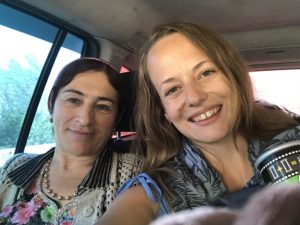Last updated on 07 February, 2019 at 03:46 am
The visit of Samarkand will not leave you indifferent. Its place on the Silk Road allowed this city to build magnificent and gigantic monuments to the glory of Islam or the tombs of the rich rulers of those time.
Getting to Samarkand from Dushanbe
After our journey in Tajikistan and Kyrgyzstan, we traveled to Uzbekistan. If the first two countries are to visit rather for their nature, Uzbekistan is distinguished by its architecture resulting from the wealth obtained during centuries by its place on the Silk Road.
Journey to the Uzbek border
In order to get to Samarkand, we first took a shared taxi from Dushanbe to the Penjikent border. If this border was closed until recently, it has now reopened, hopefully for good, significantly reducing the time to travel to Samarkand.
We shared the taxi with locals to the Penjikent bazaar (although some have already left the carearlier down on the road). I think our driver had to have a vision problem and had to miss on his speedometer the “1” in front of the 140 since it was limited to 40 km/h.
Then, we continued only both up to the border. Having not stopped at the bazaar, we hadn’t yet exchanged Uzbek soms. It followed a long negotiation to change our Tajik somoni at rate that wasn’t too bad. We should have stopped at the bazaar before continuing to have a better rate.
Crossing the Uzbek border
Border crossing for Uzbekistan is the subject of much story on the web. For a detailed explanation, you can read our article with all our tips for visiting Uzbekistan.
Getting out of Tajikistan happened very quickly: passport control, Tajik and Uzbek visa control, a stamp in the passport, and it’s was done.
We arrived then at the Uzbek part after a hundred meters of No man’s land. Our luggage is scanned and passports are quickly checked. We go to the next window, they control (again) our passports and Uzbek visas and stamp them. We continue in the building, and arrive at the exit. A last check of the stamp in the passport and visa in front of a gate and we are on the other side.
Needless to tell you, with such big eyes!
While we expected to spend several hours and be searched and interrogated (I even prepared a list of active ingredients of our medicines to prove that we had the right to keep them), the passage lasted maximum 40 minutes for both customs! No control of drugs or declaration of money that we have on neither.
At that moment, I must admit that I feared a little the border to leave the country … but, in order not to make the unbearable suspense last, everything went fine at the exit. Our hotel registration cards were not even requested.
Until now, we don’t know if we were just lucky that day, or if the customs procedures are changing, perhaps due to the new president of the country elected in 2016 and in the process of opening the country and putting in place many reforms.
From the border to Samarkand
We then went in search of the Marshrutka for Samarkand. A taxi approaches us and offers to bring us for 50’000 soms (6 CHF or 5.20 €). We refuse directly even if I don’t see any buses on the horizon. When I turn around, I see Celine climbing in a minibus, perfect she found the marshrutka!
Except it was not a marshrutka
But a minibus with a group of Tajik people of all ages leaving for Moscow to work and find a better life. We received bread and fruit. They had left for two full days of bus and made a detour for us. And not in the suburbs, but in front of the Registan, THE monument to see in Samarkand! We wanted to give them something for the trip but impossible even for a future meal. It’s the people who have the least, that gives the most.
Our hotel is a few steps away, we walk there without a problem.
Our visit of Samarkand
Samarkand has many architectural sites worth visiting. Here is our choice and our appreciation of the different sites.
Registan
The Registan is the most famous monument of Samarkand and is a must-see. Its name means “sandy place” or “desert” in Persian.

Composed of three medersas (Islamic schools) illuminated by the sun alternately during the day, it was a public square for royal proclamations and executions.


The site is very big and every medresa can and deserves to be visited. In our opinion, the most impressive is the middle one with its resplendent gold ceiling. At night, the lighting gives an additional dimension to the monument, which deserves to be seen again.


The ticket office is in front of the eastern medresa.
Gur-e Amir
Do not miss the Gur-e Amir, a magnificent mausoleum, the place of the last rest of Timur and his descendants.

It has a very important place in Persian architecture, being precursor of other Mughal tombs such as Humayun tomb in New Delhi and Taj Mahal in Agra.

The best moment to see it is at sunset or at night.


Bibi-Khanym Mosque
The Bibi-Khanym Mosque, located north of Registan, was our least preferred monument, although it has a gigantic main door (35m high).
It owes its name to the wife of Amir Timur.
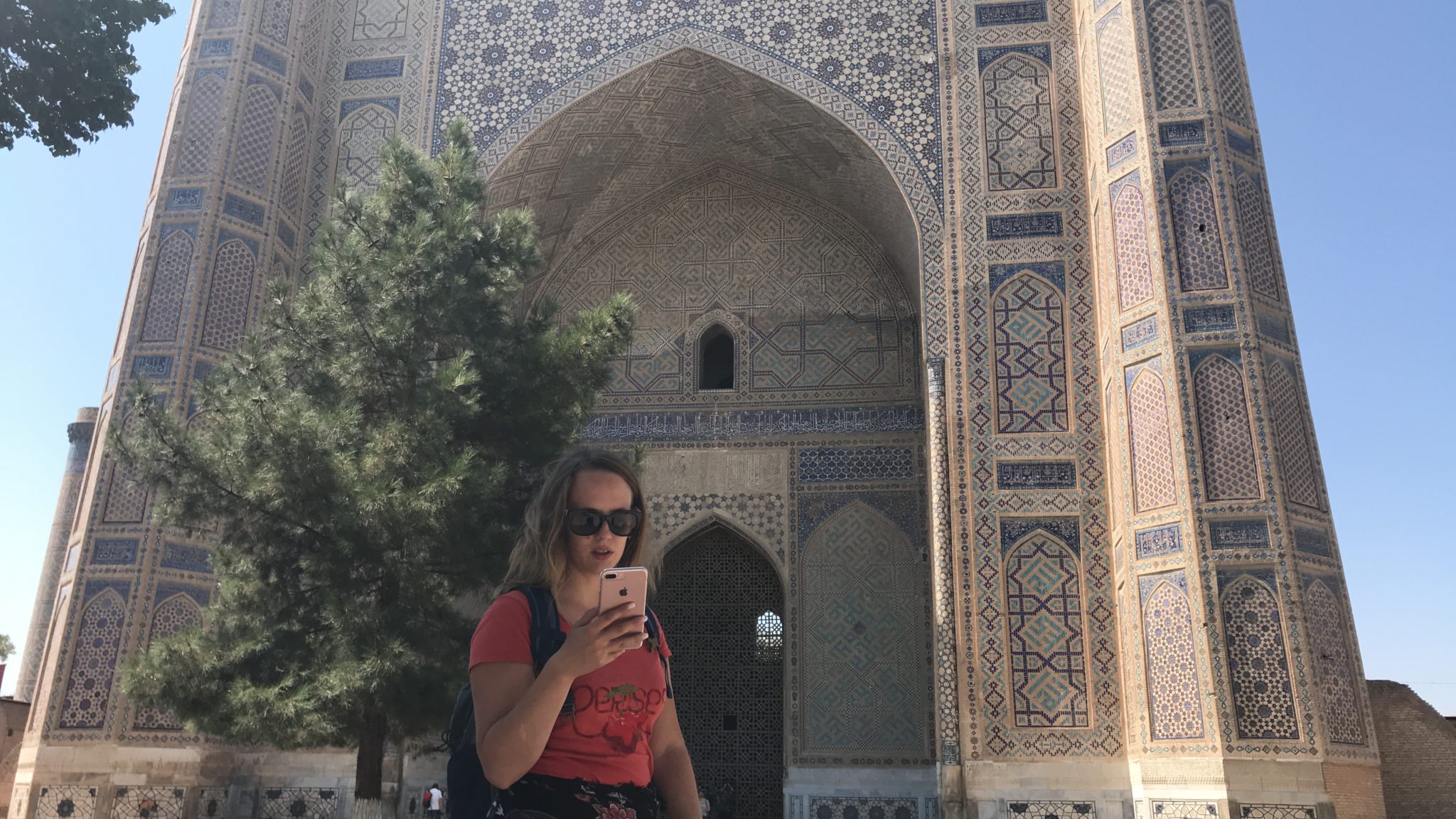

Shah-i-Zinda
We also went to the Shah-i-Zinda, set of mausoleums composed of more than 20 buildings side by side, built between the eleventh and nineteenth centuries, still in very good condition.

His name means the “living King” and comes from the legend that the cousin of the Prophet Muhammad, Kusam ibn Abbas, would be buried here.

The best time to admire them is in the morning, the sun reflecting against the facades.
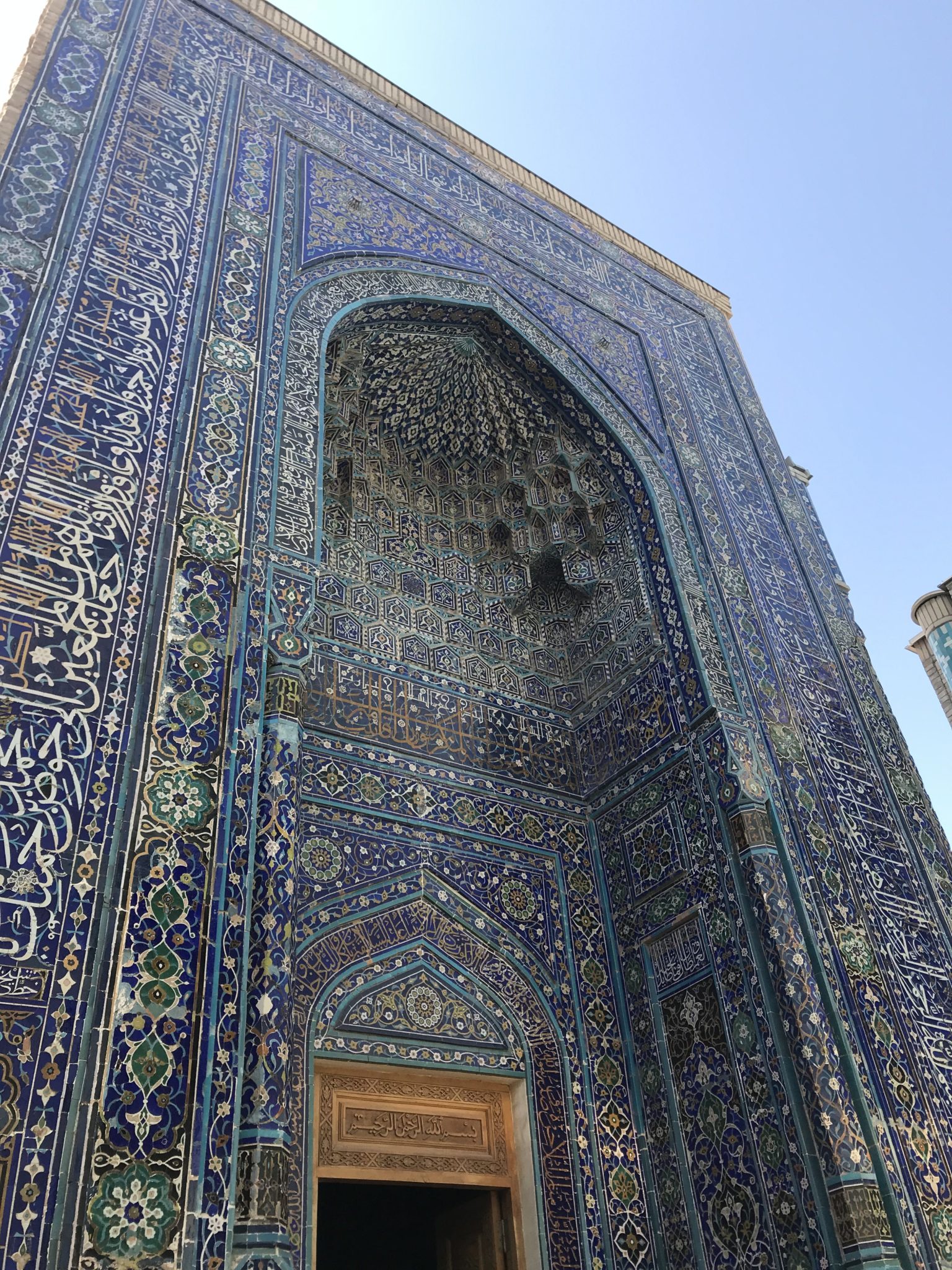
Samarkand Bazaar
Behind the Bibi-Khanym Mosque and hidden behind a wall is the Samarkand Bazaar, delineating the tourist side of the more local side of the city. The fruits and vegetables on the shelves are enough to make any occidental fruits and vegetables reseller blush, as the color and the freshness are amazing!
And much more
The city still has many mausoleums and some monuments scattered throughout the city, enough to fill at least one day of visit for the most ardent of you.

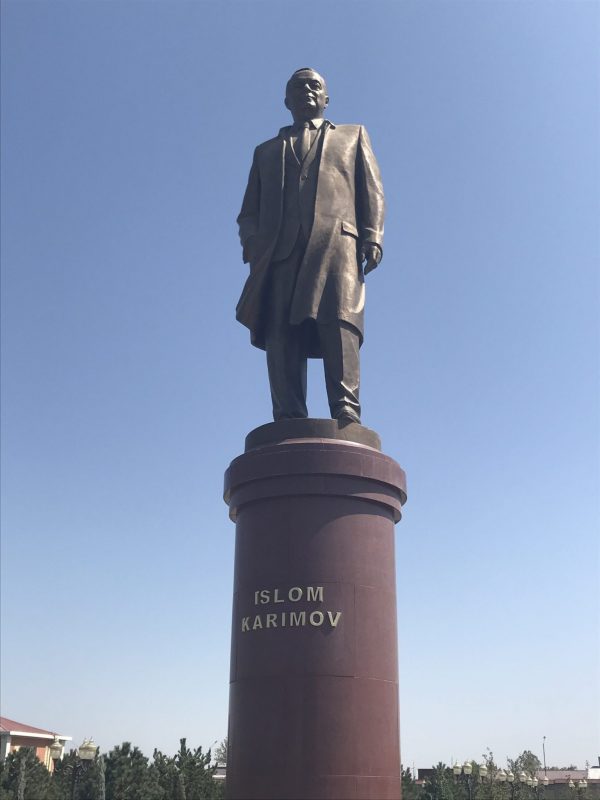
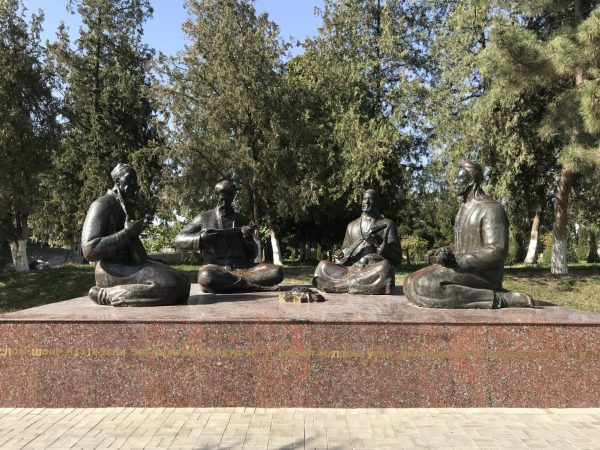
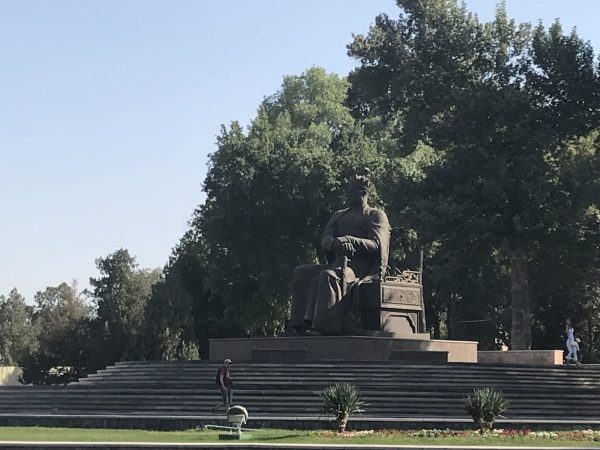
Tips for visiting Samarkand
Here are some tips specific to the city of Samarkand. You can read our tips on Uzbekistan as a whole in this article.
Where to sleep in Samarkand? Accommodations
In hotels, dollars are kings. Hotel rooms can be paid in dollars most of the time (I should say almost every time). In Samarkand, we stayed in two different hotels.
We made the first night in the hotel Jahongir. The hotel is very close to Registan and is a bit more upscale than usual. The room is clean and comfortable. The breakfast is the best of our stay in Central Asia.
On the second and third nights, we went to B&B Emir just steps from the Gour Emir. There is even a view of it from the hotel. The rooms are overlooking a courtyard, they are difficult to ventilate and are comfortable. The breakfast is ok.
Where to eat in Samarkand? The restaurants
The first night, we ate at the Oasis Garden, a trendy restaurant in Samarkand. Although more expensive than other restaurants in the area, it attracts the city’s affluent youth who dance to both Western and local hits. The terrace is large enough not to be disturbed by the music.
The other nights, we were in fastfoods local restaurants serving fast and more western cuisine.
How much are the entrances to the monuments in Samarkand?
Entrance fee for the different sites (price per person):
- Registan: 30,000 soms
- Gour Amir: 22,000 soms
- Bibi-Khanym Mosque: 22,000 soms
- Shah-i-Zinda: 12,000 soms
Dollars change in Samarkand
You will find an explanation on the use of money in Uzbekistan, on our article full of practical advice on Uzbekistan.
ATMS are almost non-existent, as everywhere else in Uzbekistan. In addition, not all banks have the right to exchange dollars. In Samarkand, the easiest way is to go to the NBU, the National Bank of Uzbekistan (Google Maps link). The counter is on the right as you enter.
Going to Samarkand from Dushanbe in Tajikistan
From Dushanbe, the shortest is to use the Penjikent border crossing. To get there, take a taxi and go to the shared taxi start location, located north of the city (the taxi know the location).
A shared taxi to the Penjikent Bazaar costs 100 somoni per person (10.50 CHF or 9.10 €), to the border add 10 more somoni. It is better to stop first at the bazaar to exchange Uzbek som to get a better rate than at the border.
After the border, you have to either take a taxi or find the marshrutka, we do not know where it leaves unfortunately.
By train, the taxi from Samarkand station to the city center should cost about 15,000 soms (1.80 CHF or 1.60 €).
Some links of this page are sponsored. It means that if you use them to do your booking, we will get a small commission without being more expensive for you.


